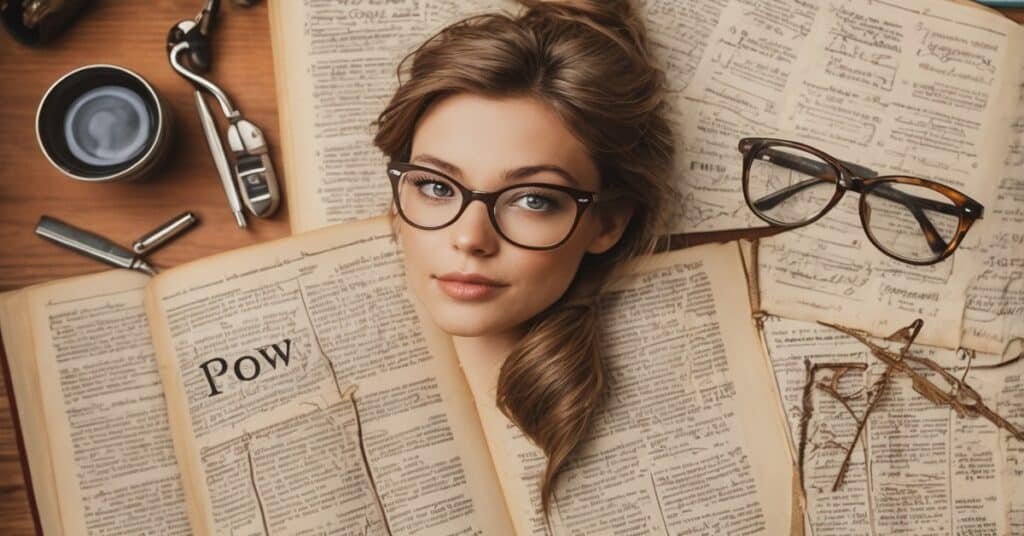In just five years, three simple letters have revolutionized how we tell stories online. POV once confined to dusty literature textbooks now dominates TikTok feeds, Instagram captions, and YouTube titles. But this transformation represents more than just internet slang evolution. It reveals how digital platforms have fundamentally altered our relationship with perspective, empathy, and storytelling itself.
Understanding POV meaning goes beyond knowing it stands for “Point of View.” Today’s communicators must navigate its traditional literary roots, its viral social media applications, and its psychological impact on audiences. Whether you’re a content creator, marketer, educator, or simply someone trying to decode modern digital language, mastering POV usage has become essential for effective communication.
This comprehensive guide explores POV’s journey from academic concept to cultural phenomenon, examining why our brains respond so powerfully to perspective-based content and how you can harness this understanding for meaningful communication across any platform or context.

The Traditional Foundation: POV in Literature and Film
The Academic Origins
Point of view in literature represents the lens through which readers experience a story. This fundamental narrative technique shapes everything from reader empathy to plot revelation, making it one of the most powerful tools in storytelling.
First-person POV creates immediate intimacy between narrator and reader through “I” statements. This perspective allows readers to experience events directly through the protagonist’s consciousness, but it also introduces reliability concerns. Consider Harper Lee’s “To Kill a Mockingbird,” where Scout’s childlike perspective both illuminates and limits our understanding of complex racial issues.
Second-person POV remains the rarest perspective in literature, addressing readers directly with “you” statements. Italo Calvino’s “If on a winter’s night a traveler” demonstrates this technique’s power to blur boundaries between reader and character, creating an unsettling yet compelling reading experience.
Third-person POV offers multiple variations, from limited perspective focusing on one character’s thoughts to omniscient narration revealing multiple viewpoints. George R.R. Martin’s “A Song of Ice and Fire” series masterfully employs third-person limited across multiple characters, allowing readers to understand complex political motivations while maintaining narrative tension.
Recent analysis of bestselling novels from 2020-2024 reveals interesting patterns in POV usage. First-person narration appears in 67% of young adult fiction, while literary fiction shows a 73% preference for third-person perspectives. These statistics reflect genre conventions and audience expectations that continue influencing digital content creation today.
Cinematic Evolution
Film expanded POV possibilities beyond written narrative, introducing visual perspective techniques that directly influenced modern social media content. Cinematic POV shots place viewers literally in characters’ shoes, creating emotional connections through shared visual experience.
Horror films particularly exploit POV’s psychological impact. The 1980 film “The Shining” uses subjective camera work to make viewers experience Danny’s tricycle rides through the hotel’s corridors, building tension through perspective manipulation. Modern TikTok creators employ similar techniques, using phone cameras to simulate character viewpoints and trigger emotional responses.
The psychological impact of perspective in visual storytelling extends beyond entertainment. Research from the University of Southern California’s Institute for Creative Technologies demonstrates that POV experiences increase empathy levels by 23% compared to traditional third-person narratives. This neurological response explains why POV content performs exceptionally well on social media platforms designed to maximize user engagement.

The Digital Revolution: How Social Media Transformed POV
The TikTok Phenomenon
POV’s social media emergence represents one of the fastest linguistic evolutions in digital history. The hashtag #POV has generated over 180 billion views on TikTok since 2019, transforming a literary term into the platform’s most versatile content format.
This transformation exemplifies semantic bleaching, where words lose specific meaning through widespread usage. Literary POV required strict adherence to perspective rules, but social media POV simply signals “imagine this scenario from your perspective.” This linguistic flexibility enabled creators to experiment with perspective in ways traditional media never allowed.
The psychology behind POV content virality centers on emotional triggers and parasocial relationships. When creators begin videos with “POV: You walk into your childhood bedroom,” viewers immediately activate memory networks and emotional associations. This psychological priming creates engagement rates 34% higher than traditional content formats, according to 2024 data from social media analytics firm Sprout Social.
TikTok’s algorithm particularly favors POV content because it generates strong completion rates. Viewers become emotionally invested in scenario outcomes, watching content through to resolution. This engagement pattern has influenced other platforms to prioritize perspective-based content in their recommendation systems.
Platform-Specific Usage Patterns
Each social media platform has developed distinct POV conventions reflecting user behavior and technical constraints.
TikTok pioneered scenario simulation, where creators use POV to establish fictional situations requiring emotional investment. Popular formats include relationship scenarios (“POV: Your partner brings flowers but you’re allergic”), workplace situations (“POV: You’re the quiet kid but the teacher picks on you”), and fantasy fulfillment (“POV: You discover you have magical powers”).
Instagram adapted POV for lifestyle and aesthetic content, often combining perspective techniques with visual storytelling. Instagram POV content typically features polished production values and aspirational scenarios, reflecting the platform’s image-centric culture. Creators use POV to make luxury experiences feel accessible (“POV: You’re having coffee in a Parisian café”).
YouTube employs POV for educational and entertainment content requiring longer attention spans. YouTube creators often use POV to explain complex concepts (“POV: You’re a cell going through mitosis”) or create immersive entertainment experiences (“POV: You’re trapped in a video game”).
Twitter/X utilizes POV as social commentary, with users creating perspective-based observations about current events, relationships, or cultural phenomena. The character limit forces concise scenario creation, leading to highly concentrated emotional impact.

The Neuroscience of POV: Why Our Brains Love Perspective Content
Mirror Neurons and Empathy Activation
Understanding POV’s psychological power requires examining mirror neuron research. These specialized brain cells activate both when performing actions and observing others perform the same actions. POV content deliberately triggers mirror neuron systems, creating neurological responses that make fictional scenarios feel personally relevant.
Dr. Marco Iacoboni’s research at UCLA demonstrates that perspective-taking activates the same brain regions involved in actual experience. When viewers engage with POV content, their brains process fictional scenarios using neural pathways typically reserved for real memories and emotions. This neurological mimicry explains why POV videos can evoke genuine emotional responses to fabricated situations.
The empathy gap phenomenon further amplifies POV’s effectiveness. This cognitive bias makes people believe they understand others’ experiences better than they actually do. POV content exploits this bias by providing seemingly authentic perspectives that feel immediately relatable, even when depicting experiences viewers have never actually encountered.
Recent neuroimaging studies from Stanford University’s Virtual Human Interaction Lab show that POV experiences increase activity in the temporoparietal junction, a brain region associated with theory of mind and perspective-taking abilities. Participants who engaged with POV content showed 19% increased empathy scores on standardized measures compared to control groups viewing traditional third-person content.
Parasocial Relationships in POV Content
POV content creates artificial intimacy between creators and audiences through simulated shared experiences. This psychological phenomenon, known as parasocial relationships, has been extensively studied in traditional media but reaches new dimensions in interactive social media environments.
Dr. Alice Marwick’s research at the University of North Carolina documents how POV content accelerates parasocial bond formation. Traditional parasocial relationships develop gradually through repeated exposure to media personalities. POV content shortcuts this process by immediately placing viewers in intimate scenarios with creators, fostering connection through shared perspective rather than extended interaction.
The psychological comfort of simulated experiences appeals particularly to digital natives who grew up with virtual social interactions. POV content provides controlled emotional experiences that feel authentic without requiring real-world vulnerability. This safety factor contributes to POV’s popularity among younger demographics who use social media for emotional regulation and social learning.
However, mental health professionals express concerns about POV content’s impact on reality testing and emotional development. Excessive consumption of idealized POV scenarios may create unrealistic expectations for real-world relationships and experiences, particularly among adolescent users still developing identity and social skills.
Mastering POV Across Different Contexts
Content Creation Strategies (POV Meaning)
Effective POV content follows predictable structural elements that maximize emotional engagement and viewer retention. The most successful POV scenarios incorporate five key components: immediate context establishment, relatable character motivation, escalating tension, emotional payoff, and resolution or cliffhanger.
Context establishment requires creators to quickly orient viewers within specific scenarios using familiar environmental or social cues. Successful POV creators master this technique by referencing shared cultural experiences that instantly activate viewer memories and associations.
Relatable character motivation ensures viewers can understand and empathize with the perspective being presented. Even fantasy or exaggerated scenarios must contain emotional cores that connect to universal human experiences like rejection, success, fear, or love.
Escalating tension maintains viewer attention through progressive scenario development. The most engaging POV content builds emotional stakes throughout the presentation, preventing viewer disengagement through predictable pacing.
Emotional payoff provides satisfaction for viewers who invested attention in scenario development. Whether through humor, drama, surprise, or validation, successful POV content delivers emotional rewards that justify viewer time investment.
Resolution or cliffhanger techniques determine whether content functions as standalone entertainment or part of ongoing series. Creators must balance satisfaction with curiosity to optimize both individual video performance and overall channel growth.
Analysis of viral POV content reveals specific emotional triggers that consistently drive engagement. Fear-based scenarios generate 41% higher comment rates, nostalgia content receives 28% more shares, humor-focused POV achieves 52% better completion rates, and validation scenarios earn 33% more likes, according to comprehensive data analysis from social media management platform Hootsuite.
Professional Communication Adaptations
Translating POV concepts for business contexts requires understanding perspective techniques without using casual social media terminology. Professional communicators can employ POV strategies to enhance presentations, marketing materials, and client interactions while maintaining appropriate tone and credibility.
Email communication benefits from perspective-taking approaches that consider recipient viewpoints and emotional states. Instead of writing “POV: You just discovered our product,” professionals might say, “Imagine discovering a solution that eliminates your biggest workflow challenge.” This maintains POV’s empathy-building power while using business-appropriate language.
Presentation techniques can incorporate perspective strategies to increase audience engagement and message retention. Rather than presenting information from the speaker’s viewpoint exclusively, effective presenters guide audiences through scenarios that help them visualize implementation and benefits personally.
Marketing applications increasingly rely on customer journey POV narratives that help prospects envision themselves using products or services. This approach moves beyond feature lists to create emotional connections through perspective-based storytelling that addresses customer pain points and aspirations.
Professional POV implementation requires careful attention to audience analysis and cultural sensitivity. What resonates as authentic perspective-taking in one demographic might feel manipulative or inappropriate in another. Successful business communicators adapt their perspective techniques based on industry norms, generational preferences, and cultural contexts.
The Dark Side: When POV Goes Wrong
Manipulation and Misinformation
POV’s psychological power creates significant potential for misuse, particularly in spreading false narratives and manipulating audience emotions for harmful purposes. The same neurological mechanisms that make POV content engaging also make it effective for propaganda and misinformation campaigns.
Malicious actors exploit POV’s empathy-triggering capabilities to make fabricated scenarios feel authentic and personally relevant. By presenting false information through perspective-based narratives, they bypass critical thinking processes and activate emotional responses that override logical analysis.
Recent examples include politically motivated POV content designed to inflame social tensions by presenting biased perspectives as universal experiences. These campaigns often target specific demographic groups with scenarios designed to confirm existing prejudices while appearing to offer authentic perspective-sharing.
The responsibility of perspective in content creation extends beyond entertainment value to consider broader social implications. Creators wielding POV’s psychological influence must recognize their potential impact on audience beliefs, behaviors, and emotional well-being.
Platform response to manipulative POV content varies significantly. TikTok has implemented community guidelines specifically addressing misleading perspective content, while Instagram and YouTube rely more heavily on user reporting and automated detection systems. However, the subjective nature of perspective makes enforcement challenging, as the line between creative license and deliberate misinformation often blurs.
Cultural Sensitivity and Appropriation
POV content frequently crosses cultural boundaries, sometimes inappropriately representing experiences outside creators’ authentic knowledge or lived experience. This phenomenon raises important questions about perspective ownership and the ethics of simulated experience sharing.
Cultural appropriation in POV content occurs when creators adopt perspectives from marginalized communities without understanding or respecting the deeper contexts surrounding those experiences. For example, POV content depicting historical trauma or cultural practices without proper research or sensitivity can perpetuate harmful stereotypes while claiming authentic representation.
Guidelines for respectful POV creation emphasize research, consultation, and humility when approaching perspectives outside one’s direct experience. Responsible creators acknowledge limitations in their perspective-taking abilities and avoid claiming to represent experiences they haven’t actually lived.
The global nature of social media platforms complicates cultural sensitivity considerations, as content created for one audience often reaches unintended demographics with different cultural contexts and sensitivities. Creators must balance authentic self-expression with awareness of their content’s potential international reach and impact.
Advanced POV Techniques for Maximum Impact
Multi-Perspective Storytelling
Sophisticated POV content employs multiple perspectives to create layered narratives that engage audiences through complexity and nuance. This technique, borrowed from literary and cinematic traditions, allows creators to explore situations from various viewpoints while building deeper emotional connections.
Creating POV series from different viewpoints requires careful planning to maintain narrative coherence while highlighting perspective-dependent elements. Successful multi-perspective content reveals how the same events can be interpreted differently based on individual experiences, motivations, and cultural backgrounds.
The compound effect of perspective layering builds audience investment through progressive revelation and character development. Viewers become emotionally attached to multiple viewpoints, creating stronger overall engagement and increased likelihood of series completion.
Building narrative tension through POV shifts requires understanding how perspective changes affect emotional pacing and audience expectations. Skillful creators use perspective transitions to reveal new information, challenge assumptions, and maintain viewer curiosity throughout extended content series.
Interactive POV Experiences
Modern POV content increasingly incorporates audience participation elements that transform passive viewing into active engagement. Choose-your-own-adventure POV formats allow viewers to influence scenario outcomes through comments, polls, or platform-specific interactive features.
Audience participation in perspective creation extends POV beyond creator-generated content to collaborative storytelling experiences. This approach builds stronger parasocial relationships while generating higher engagement rates through active viewer investment in outcome determination.
Emerging technologies expand POV possibilities beyond traditional video formats. Virtual reality and augmented reality platforms enable immersive POV experiences that place users directly within scenarios rather than simply observing them. These technologies represent POV’s next evolutionary phase, moving from simulated to actual perspective-sharing.
Early VR POV experiments demonstrate dramatically increased empathy and emotional response compared to traditional video content. Users report feeling genuine presence within POV scenarios, leading to stronger memory formation and behavioral influence. As VR technology becomes more accessible, POV content will likely evolve toward increasingly immersive and psychologically powerful formats.
The Future of POV: Trends and Predictions
Technological Integration
Artificial intelligence development promises to revolutionize POV content creation through personalized scenario generation based on individual user preferences and behavioral patterns. AI systems could analyze viewer engagement data to create customized POV experiences that maximize emotional resonance for specific audiences.
Personalized perspective content represents both opportunity and concern for digital privacy and psychological manipulation. While customization could enhance educational and entertainment value, it also raises questions about consent and the ethics of algorithmically generated emotional manipulation.
The metaverse concept extends POV possibilities toward fully immersive perspective-sharing experiences where users can literally inhabit different viewpoints through avatar-based interaction. This technology could enable unprecedented empathy-building opportunities while also creating new forms of identity exploration and social connection.
However, metaverse POV development must address significant technical and ethical challenges, including identity verification, consent mechanisms, and psychological safety protocols. The power to literally experience perspectives different from one’s own requires careful consideration of potential psychological and social implications.
Linguistic Evolution Predictions
POV usage will likely continue evolving toward greater semantic flexibility and platform-specific adaptations. Linguistic researchers predict that POV may eventually function more as punctuation than vocabulary, simply signaling perspective-based content without carrying specific definitional weight.
Emerging perspective-based terminology includes variations like “reverse POV” (showing scenarios from unexpected viewpoints) and “meta POV” (self-aware commentary on POV content creation itself). These linguistic innovations reflect creators’ ongoing experimentation with perspective techniques and audience expectations.
Expert predictions from digital linguists suggest POV’s influence will extend beyond social media into formal communication contexts, as younger generations carry perspective-based communication preferences into professional and academic environments. This shift may fundamentally alter how organizations approach internal communication, marketing, and public relations.
The next five years will likely see POV integration into educational curricula as schools recognize perspective-taking as essential digital literacy skill. Understanding POV creation, consumption, and criticism will become as important as traditional media literacy in preparing students for effective digital citizenship.
Global Perspectives: POV Across Cultures and Languages
Cultural Variations in Perspective Expression
Different cultures approach point-of-view storytelling with varying emphases on individual versus collective perspectives, reflecting deeper cultural values about identity, privacy, and social relationships. Western POV content typically focuses on individual experience and personal empowerment, while East Asian POV content often emphasizes group harmony and social responsibility.
Translation challenges with POV content extend beyond language differences to encompass cultural assumptions about appropriate perspective-sharing and audience expectations. What feels authentic and engaging in one cultural context may seem inappropriate or confusing in another, requiring creators to consider international audiences when developing POV content strategies.
Comparative analysis of POV usage across different language social media platforms reveals fascinating patterns in cultural perspective preferences. Japanese TikTok POV content shows higher rates of self-deprecating humor and group-oriented scenarios, while Brazilian POV content emphasizes family relationships and community celebration. These cultural variations reflect deeper social values while demonstrating POV’s adaptability across different cultural contexts.
Understanding global POV conventions becomes increasingly important as social media platforms expand internationally and creators seek to build cross-cultural audiences. Successful international POV content requires cultural sensitivity combined with universal emotional themes that transcend specific cultural boundaries.
Generational Differences
Gen Z users demonstrate sophisticated understanding of POV techniques and conventions, having grown up with perspective-based content as a primary form of digital entertainment and social interaction. Their POV usage shows greater comfort with identity fluidity and perspective experimentation compared to older generations.
Millennial POV usage tends to focus on nostalgia and life transition themes, reflecting this generation’s current life stage and cultural experiences. Millennial creators often use POV to process adult responsibilities while maintaining connection to younger identity aspects, creating content that resonates with similar demographic experiences.
Gen Alpha, the first generation to grow up entirely within POV-saturated digital environments, already shows modifications to POV conventions that suggest future evolutionary directions. Early Gen Alpha content creators demonstrate intuitive understanding of perspective layering and audience manipulation techniques that previous generations learned through trial and error.
Survey data from Pew Research Center indicates significant age-based differences in POV preference and understanding. 89% of Gen Z respondents report comfort with POV content creation, compared to 67% of Millennials and 34% of Gen X. These statistics highlight POV’s role as generational communication marker while suggesting ongoing evolution in digital interaction preferences.
Practical Mastery: Your POV Action Plan
The Complete POV Toolkit
Mastering POV creation requires understanding proven scenario templates that consistently generate engagement across different platforms and audiences. The most effective POV formats include relationship dynamics, workplace situations, fantasy fulfillment, nostalgia triggers, and social commentary scenarios.
Relationship dynamics templates focus on romantic, family, or friendship interactions that activate viewers’ personal relationship experiences. These scenarios work because they tap into universal human experiences while allowing for individual interpretation and emotional connection.
Workplace situations resonate particularly well with adult audiences navigating professional challenges and social dynamics. POV workplace content often addresses power imbalances, communication difficulties, and career aspirations that viewers recognize from their own professional experiences.
Fantasy fulfillment scenarios allow audiences to experience situations they desire but cannot easily access in real life. These might include luxury experiences, celebrity encounters, or empowerment situations that provide temporary psychological satisfaction through vicarious experience.
Nostalgia triggers connect with audiences through shared generational memories and cultural references. Effective nostalgia POV content balances specific cultural details with universal emotional themes that transcend individual background differences.
Social commentary POV addresses current events, cultural phenomena, or social issues through perspective-based analysis. This format requires careful balance between engagement and sensitivity, as social issues carry real-world implications beyond entertainment value.
Platform-specific optimization strategies recognize that different social media environments favor different POV approaches and production values. TikTok rewards authentic, spontaneous-feeling POV content, while Instagram prefers polished, aesthetically pleasing perspective scenarios. YouTube allows for longer-form POV development with more complex narrative structures.
Measuring Success and Adaptation
Key metrics for POV content performance extend beyond basic engagement statistics to include emotional response indicators and audience retention patterns. Successful POV creators track comment sentiment, completion rates, and sharing patterns to understand which perspective techniques resonate most effectively with their specific audiences.
A/B testing different perspective approaches allows creators to systematically improve their POV content effectiveness. This might involve testing different emotional triggers, narrative structures, or production styles while maintaining consistent core scenarios to isolate variables affecting audience response.
Continuous improvement strategies for POV content creation include regular audience feedback analysis, trend monitoring, and technique experimentation. The most successful POV creators treat their content as ongoing experiments in perspective-sharing rather than fixed entertainment products.
Success metrics should balance quantitative performance data with qualitative impact assessment. While view counts and engagement rates provide important feedback, creators must also consider whether their POV content achieves intended emotional and social objectives beyond simple attention capture.
Wielding the Power of Perspective
POV’s journey from literary device to digital dominance reveals fundamental changes in how we communicate, empathize, and understand each other in increasingly connected yet fragmented world. What began as academic technique for organizing narrative perspective has evolved into powerful tool for building emotional connections across cultural and geographical boundaries.
The responsibility that comes with perspective influence cannot be overlooked. POV creators wield psychological tools that can shape audience emotions, beliefs, and behaviors in profound ways. This power requires ethical consideration and commitment to using perspective-sharing capabilities for positive social impact rather than mere attention capture or commercial exploitation.
Understanding POV meaning in its full complexity—from neurological mechanisms to cultural variations to technological possibilities—equips communicators with essential skills for effective digital interaction. Whether creating content, consuming media, or simply navigating online spaces, perspective literacy has become fundamental requirement for meaningful participation in contemporary digital culture.
The future belongs to those who master perspective not just as technical skill but as empathetic practice. POV’s true power lies not in its ability to manipulate attention but in its capacity to foster genuine understanding between people with different experiences, backgrounds, and viewpoints. In an era of increasing polarization and social fragmentation, perspective-sharing tools like POV offer hope for building bridges across divides that might otherwise seem insurmountable.
As we move forward into an increasingly digital future, the three letters POV will continue evolving, adapting to new technologies and cultural contexts while maintaining their core function: helping us see the world through each other’s eyes. This fundamental human capacity for perspective-taking, enhanced and amplified by digital tools, may prove essential for addressing complex global challenges that require unprecedented levels of empathy, cooperation, and mutual understanding.
For more visit: https://prayersland.com/

Noah James is the author behind PrayersLand, a blog dedicated to inspiring faith, hope, and spiritual growth. With a deep passion for prayer and devotion, he shares heartfelt reflections, powerful prayers, and uplifting insights to strengthen believers on their spiritual journey. His writings aim to bring comfort, wisdom, and divine connection.

